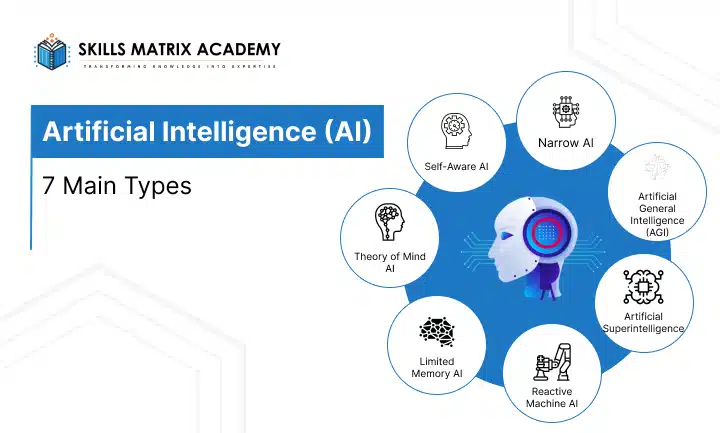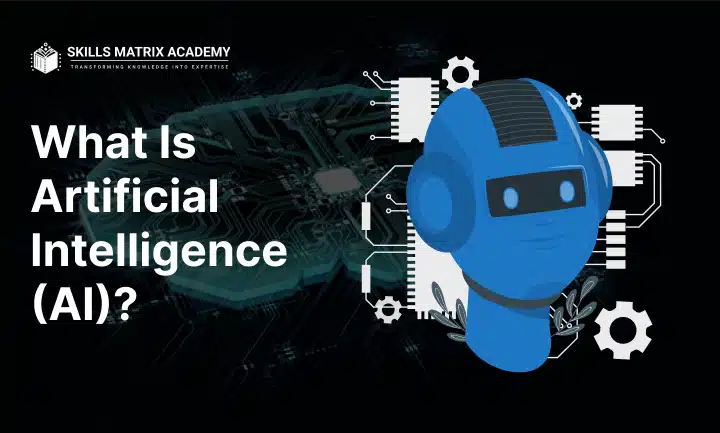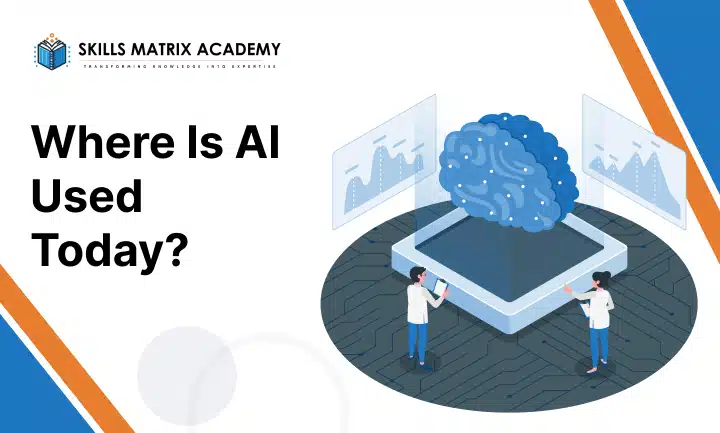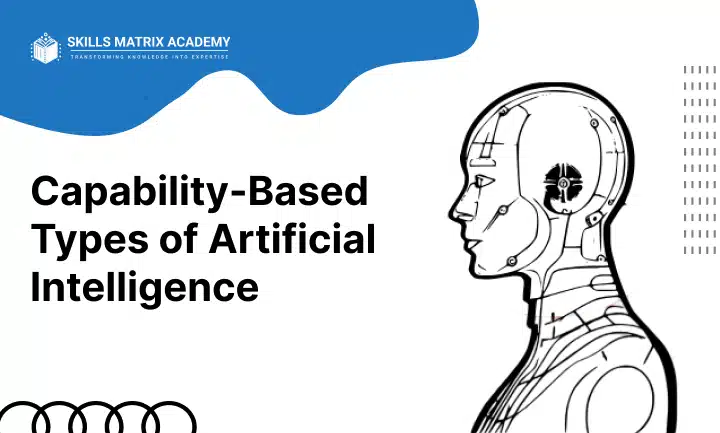
Artificial Intelligence (AI) is transforming the way the world operates. It’s one of the fastest-growing technologies that’s transforming every industry today.
AI technology helps increase process efficiency, automate tasks, and make accurate predictions about future trends. But not all AI is the same. There are different types of AI, each designed to solve unique problems and improve daily life.
At our IT training institute in Jaipur, students learn how AI development works and how it powers real-world solutions—from Siri to autonomous cars.
What Is Artificial Intelligence (AI)?

Artificial Intelligence is a field of computer science that aims to build intelligent machines capable of thinking and learning like humans. These AI systems can handle data processing, speech recognition, pattern analysis, object detection, and even decision making without human help.
AI allows machines to copy human intelligence and make smart choices faster and more accurately.
Where Is AI Used Today?

AI applications are part of every major sector: IT, healthcare, finance, education, manufacturing, and transportation.
- In healthcare, AI tools help doctors diagnose and treat patients faster.
- In finance, AI systems detect fraud and manage investments.
- In manufacturing, AI supports automation and predictive maintenance.
Our IT training institute in Jaipur helps learners master these AI technologies so they can build smart and scalable business solutions.
7 Types of Artificial Intelligence

- Narrow AI: This type of AI is built to perform one specific task — like facial recognition or voice assistants. It can’t think or learn beyond what it’s programmed to do.
- Artificial General Intelligence (AGI): AGI can think, learn, and solve problems just like a human. It’s designed to understand different situations and make smart decisions.
- Artificial Superintelligence: This is the next level of AI — smarter and faster than humans. It can process huge amounts of data and make complex decisions beyond human ability.
- Reactive Machine AI: These AIs respond to what’s happening right now. They can react to situations but can’t remember past experiences or store data for the future.
- Limited Memory AI: This AI can learn from past data and make better choices over time. It’s commonly used in self-driving cars and modern robots.
- Theory of Mind AI: This AI can understand and respond to human emotions. It combines emotional awareness with learning abilities to communicate naturally.
- Self-Aware AI: The most advanced stage of AI. It has human-like intelligence, self-awareness, and the ability to recognize emotions — both its own and others’.
Capability-Based Types of Artificial Intelligence

Artificial Intelligence (AI) has changed how machines think, learn, and act. Based on how AI learns and applies knowledge, it is divided into three capability-based categories — Narrow AI, Artificial General Intelligence (AGI), and Artificial Superintelligence (ASI).
-
Narrow AI
Narrow AI, also known as Artificial Narrow Intelligence (ANI) or Weak AI, is the most common type of AI today. It focuses on performing specific tasks with speed and accuracy.
These systems are trained for one purpose only. They can’t think outside their program or learn new skills on their own. In short, Narrow AI is smart — but not flexible.
We use Narrow AI every day.
Examples include self-driving cars, virtual assistants like Siri or Alexa, and recommendation systems used by Netflix and Amazon.
These tools use Machine Learning (ML), Natural Language Processing (NLP), and neural networks to operate.
So, when you ask Siri for directions or see product suggestions on Amazon, that’s Narrow AI in action.
-
Artificial General Intelligence (AGI)
Artificial General Intelligence (AGI) — also called Strong AI — is the next big step in AI evolution. Unlike Narrow AI, AGI aims to think, learn, and reason like humans.
Imagine a machine that can solve new problems, understand emotions, and make smart decisions across many fields — that’s AGI.
It would be able to adapt to any task without special training.
AGI doesn’t exist yet, but it’s the ultimate goal for researchers.Technologies like supercomputers, quantum hardware, and generative AI tools such as ChatGPT are helping scientists move closer to AGI.
Once achieved, AGI could revolutionize industries like healthcare, education, finance, and manufacturing — bringing a new level of automation and creativity.
It’s the dream of building machines that learn like humans, not just follow commands.
-
Artificial Superintelligence (ASI)
Artificial Superintelligence (ASI), or Super AI, is the most advanced — and most mysterious — type of AI. This level of AI would surpass human intelligence in every way.
Experts believe that once machines reach AGI, they could begin improving themselves automatically.That’s when ASI would emerge — AI systems smarter, faster, and more capable than people.
According to Dave Rogenmoser, CEO of Jasper, Super AI could “exceed human capabilities in every area,” including creativity, problem-solving, and emotional intelligence.
While ASI remains mostly a theoretical concept, it represents the final stage of AI evolution — where intelligent systems might think beyond human control.
It’s the stage that fuels talk about AI singularity — when machines could act and make decisions entirely on their own.
Functionality-Based Types of Artificial Intelligence
While capability defines how smart an AI is, functionality defines how it works. Based on how AI learns and interacts, it is divided into four functionality-based types — Reactive Machine AI, Limited Memory AI, Theory of Mind AI, and Self-Aware AI.
-
Reactive Machine AI
Reactive Machine AI is the simplest form of Artificial Intelligence. These systems respond to situations in real time but cannot store past experiences or learn from them.
They only act on the current input and perform predefined actions.Because they lack memory, their intelligence is limited — but still useful for certain tasks.
Examples of Reactive Machine AI
- IBM Deep Blue: The famous AI chess computer that defeated grandmaster Garry Kasparov in 1997. It analyzed the board and made moves based on logic, not memory.
- Netflix Recommendation Engine: Uses pattern analysis to suggest movies or shows based on user activity.
While Reactive AI doesn’t evolve or adapt, it laid the foundation for early AI systems and continues to help in automation and data processing.
-
Limited Memory AI
Limited Memory AI is smarter.It can store data temporarily and use past experiences to make better decisions. Think of it as a machine’s short-term memory.
These systems use deep learning and neural networks to process data, just like human neurons. By learning from experience, they can adjust their behavior over time.
Most modern AI technologies — such as chatbots, virtual assistants, and self-driving cars — use this model.
Examples of Limited Memory AI
- Chatbots & Virtual Assistants: They remember user preferences and provide more personalized answers.
- Self-Driving Cars: Use past driving data and real-time information to detect obstacles, decide when to stop, and predict road behavior.
Limited Memory AI is the backbone of today’s AI applications — from IT and healthcare to finance and transportation.It improves business efficiency, supports predictive analytics, and drives automation.
-
Theory of Mind AI
Theory of Mind AI takes things a step further. It’s designed to understand human emotions, beliefs, and intentions — a skill known as emotional intelligence.
This kind of AI could interpret your tone, mood, or facial expressions and adjust its response accordingly. Imagine an AI assistant that notices you’re stressed and changes its voice or actions to help you feel better.
Theory of Mind AI is still in the research phase, but it could transform education, healthcare, and customer service by making interactions more human-like.
However, it also raises ethical challenges, such as how machines interpret emotions or handle sensitive data.
It’s a major step toward a future where AI systems can connect with people emotionally, not just logically.
-
Self-Aware AI
Self-Aware AI is the final and most advanced stage of Artificial Intelligence. At this point, machines wouldn’t just understand emotions — they would be aware of their own existence.
This stage is often referred to as the AI singularity — where AI becomes conscious, self-thinking, and capable of independent decisions.
A Self-Aware AI would have its own emotions, reasoning, and goals. It could analyze its actions, reflect on mistakes, and make choices like a human.
While it’s still a hypothetical idea, Self-Aware AI represents the ultimate milestone in AI development.
However, it also poses serious concerns about control, ethics, and safety — since such systems could act without human oversight.If achieved, Self-Aware AI would mark a new era — one where intelligent machines think, feel, and create independently. It’s both an exciting and uncertain future for AI, technology, and humanity.
Additional Types of Artificial Intelligence

Artificial Intelligence (AI) comes in many forms. Some AI technologies are created for specific purposes, while others are built for general learning. These application-based AI systems are all around us — from the apps we use daily to the robots working in factories.
Let’s look at some of the most important types of Artificial Intelligence you should know.
-
Machine Learning (ML)
Machine Learning (ML) is a core part of AI technologies. While many people think AI and ML are the same, Machine Learning is actually a subset of AI.
It focuses on building algorithms that can learn from data and get smarter over time. The best part? These systems don’t need to be programmed every time — they improve automatically as they process more data.
Machine Learning models study huge amounts of information, recognize patterns, and make predictions. They help in everything from online shopping to self-driving cars.
Machine Learning Examples:
- Facial Recognition: Apps like Apple Face ID use Machine Learning during development. They analyze thousands of facial images to identify unique features.
- Product Recommendations: Streaming platforms and e-commerce sites use ML to suggest what you might like. They look at your past behavior and predict what you’ll want next.
Thanks to Machine Learning, today’s AI systems can make accurate predictions, automate tasks, and personalize user experiences.
-
Natural Language Processing (NLP)
Natural Language Processing (NLP) is another exciting branch of Artificial Intelligence. It helps computers understand, interpret, and generate human language — just like people do.
NLP is the reason tools like ChatGPT and other generative chatbots can hold realistic conversations. It works by breaking text into smaller pieces (called tokens) like words or phrases, making it easier for AI to analyze and respond.
Natural Language Processing Examples:
- Language Translation: Tools like Google Translate use NLP to translate text from one language to another. First, the system breaks the text into parts, studies its meaning using syntactic and semantic analysis, and then converts it into another language using an encoder and decoder.
- Chatbots and Voice Assistants: NLP helps Siri, Alexa, and customer service bots understand speech and give accurate replies.
This type of AI powers most AI-driven communication tools, helping businesses automate interactions and improve customer experiences.
-
AI in Robotics
AI in Robotics combines intelligence with movement. This is where Artificial Intelligence meets machines that can think and act.
AI helps robots see, learn, and respond to their surroundings using machine vision and sensors. Robots can now do repetitive jobs like sorting packages, harvesting crops, or scanning medical images in hospitals.
The next generation of robots goes even further. Collaborative robots can safely work beside humans. Meanwhile, general-purpose robots can take voice commands and learn new tasks independently.
AI in Robotics Examples:
- Figure AI: This company builds bipedal humanoid robots such as Figure 01 and Figure 02. They’re designed to think like humans and help address labor shortages.
- Tesla Optimus: Tesla’s humanoid robot can walk, carry items, and adapt to its environment. It’s built to perform various general tasks in industries and homes.
AI is truly transforming robotics — making machines more autonomous, intelligent, and useful in everyday life.
-
Computer Vision
Computer Vision gives AI the power to see and understand visual information. It’s one of the most advanced branches of AI technology.
With Computer Vision, AI can detect and track moving objects, analyze images, and even map environments. It’s used in many fields, from security and surveillance to healthcare and manufacturing.
A major part of this is image recognition — the ability to identify and classify what’s in an image.
Computer Vision Example:
- Facial Recognition: This is the most common example of computer vision. It allows your phone to recognize your face and unlock automatically. It’s fast, safe, and highly accurate.
Beyond smartphones, Computer Vision helps doctors analyze medical scans, factories inspect products, and self-driving cars detect obstacles on the road.
-
Expert Systems
Expert Systems are among the earliest and most foundational forms of Artificial Intelligence (AI). These systems solve complex problems by mimicking how human experts think.
They use rule-based decision-making, meaning they follow a set of logical rules to reach conclusions. There are two main methods used:
- Forward Chaining: Starts from facts and builds toward a goal.
- Backward Chaining: Begins with a desired outcome and traces backward to identify the facts or conditions that support it.
Expert Systems Example:
- MYCIN: One of the first expert systems, MYCIN was designed to help doctors identify bacterial infections and choose treatments. It used backward chaining to explain how it reached its conclusions.
Today, expert systems are used in areas like finance, engineering, and healthcare for decision-making and problem-solving.
-
Neurosymbolic AI
Neurosymbolic AI is one of the most exciting innovations in modern AI technologies. It combines two approaches — neural networks (used for pattern recognition) and symbolic AI (used for logical reasoning).
This hybrid AI model can learn from data while also using logic and rules to solve problems. It’s more advanced than regular AI because it can reason, explain its decisions, and handle complex tasks.
It also works efficiently with both GPUs and CPUs, making it faster and more flexible.
Neurosymbolic AI Example:
- Amazon Vulcan Robots: These AI-powered robots use automated reasoning and spatial maneuvering to move, pick up, and sort items in warehouses. Neural networks help them recognize and classify objects accurately.
Neurosymbolic AI plays a huge role in fields like autonomous vehicles, robotics, and drug discovery, where precision and intelligence are critical.
Conclusion
Artificial Intelligence (AI) is one of the most fascinating and fast-evolving areas of computer science. It focuses on building intelligent machines that can think, learn, and make decisions like humans.
While researchers are working hard to achieve Artificial General Intelligence (AGI) and Artificial Superintelligence (ASI), both remain goals for the future. For now, Narrow AI is the only form of AI humans have mastered — and it’s already transforming industries through AI-powered solutions and machine learning.
From AI in healthcare to AI in manufacturing, these AI systems are improving process efficiency, automation, and business productivity. They help analyze customer behavior, optimize AI in business operations, and reduce costs through predictive analytics.
The future of AI holds massive potential. As AI technology continues to evolve, it will redefine how humans interact with AI tools, enabling smarter digital transformation and unlocking new levels of innovation worldwide.








